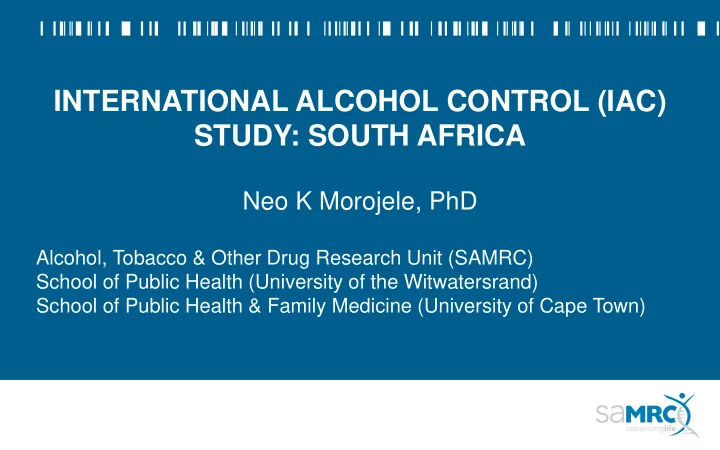

INTERNATIONAL ALCOHOL CONTROL (IAC) STUDY: SOUTH AFRICA Neo K Morojele, PhD Alcohol, Tobacco & Other Drug Research Unit (SAMRC) School of Public Health (University of the Witwatersrand) School of Public Health & Family Medicine (University of Cape Town)
OVERVIEW • Background to IAC study • Background to IAC survey: South Africa • Adolescents’ exposure to alcohol marketing • Discussion
BACKGROUND • A multi-country collaborative research project • Measures the impacts of key national level alcohol control policies in different countries • Assesses changes in drinking behaviour before and after policy changes to evaluate alcohol control policies
BACKGROUND • Conceived in 2011 • Started with 5 countries: New Zealand, England, Scotland, South Korea and Thailand • Currently involves 11 countries (both LMIC and high income countries)
PARTICIPATING COUNTRIES Partner logo
METHODS Longitudinal Survey • Includes drinkers (and non-drinkers in some countries) • Assesses alcohol consumption, perceptions of alcohol affordability, availability, and enforcement and support for policy Alcohol Environment Protocol (AEP) • Assesses alcohol policy environment in each country
IAC STUDY SOUTH AFRICA Investigators • PI: Prof Charles Parry; Co-PI: A/Prof Neo Morojele • SAMRC: Alcohol, Tobacco and Other Drug Research Unit Funder • International Development Research Centre (Canada)
STUDY SITE • City of Tshwane Metropolitan Municipality (CTMM), which includes the executive capital of South Africa (Pretoria), and surrounding areas • Population: 2.3 million • Unemployment: 19.8% • Region of about 90 km 2
STUDY SITE
METHODS We used multi-stage stratified cluster random sampling, involving selection of: – 35 Wards (in regions) – 364 Census Enumeration Areas (within wards) – Households (within EAs) – Adults/adolescents within households
QUESTIONNAIRE MEASURES • Demographic factors Alcohol consumption • Purchasing behaviour • Attitudes and perceptions • • Exposure to alcohol brand marketing (16 items): “In the last 6 months have you noticed any (alcohol) brands or products being advertised?” – Traditional (e.g. television, billboards, signs at shops, merchandise, radio, magazines, newspapers) – Sponsorships (sports, music events, TV programmes/films, celebrities) – Special price offers (on TV/radio/newspapers, free offers when buying alcohol) – Electronic media (e.g. websites, SMS, FB, emails) Response options: Yes, No, Don’t know (responses “No” and “Don’t know” were combined)
DEMOGRAPHIC CHARACTERISTICS OF SAMPLE OF DRINKERS (N=2046) Males Females Total (N=1310) (N=736) (N=2046) AGE Mean (SD) 33.1 (11.9) 33.8 (12.9) 33.4 (12.3) N (%) N (%) N (%) AGE Adolescents (16-17) 45 (3.44) 26 (3.53) 71 (3.47) GROUP Adults (18-65) 1265 (96.6) 710 (96.5) 1975 (96.5) ‘RACE’* Black 1065 (81.3) 473 (64.3) 1538 (75.2) Coloured 103 (7.9) 126 (17.1) 229 (11.2) Indian 18 (1.4) 10 (1.4) 28 (1.4) White 124 (9.5) 127 (17.3 251 (12.3)
PERCENTAGE OF ADOLESCENTS (DRINKERS AND NON-DRINKERS) REPORTING EXPOSURE TO ALCOHOL BRANDS/PRODUCTS VIA VARIOUS METHODS/MEDIA (UNWEIGHTED) (N=869) 100 91 87 90 81 81 80 77 80 70 70 63 57 60 51 50 46 44 50 40 30 23 20 12 7 10 0
FINAL COMMENT • Adolescents (both drinkers and non-drinkers) have very high levels of exposure to alcohol adverts (e.g. > 90% on TV) • Very high levels of exposure to alcohol adverts may have contributed to shift in societal norms regarding alcohol and alcohol consumption in SA • Further work on the IAC study will involve examining associations between exposure to advertisements and alcohol consumption cross-sectionally and over time
ACKNOWLEDGEMENTS International Development Research Centre (IDRC). • Professor Sally Caswell, DrTasia Huckle, Dr Thomas Graydon-Guy and Dr Lanuola • Asiasiga (SHORE and Whariki Research Centre, Massey University) • Colleagues from international network of IAC studies • Research staff from South African Medical Research Council (Naledi Kitleli & Frans Masango) • Study participants from the Tshwane community study site
Recommend
More recommend